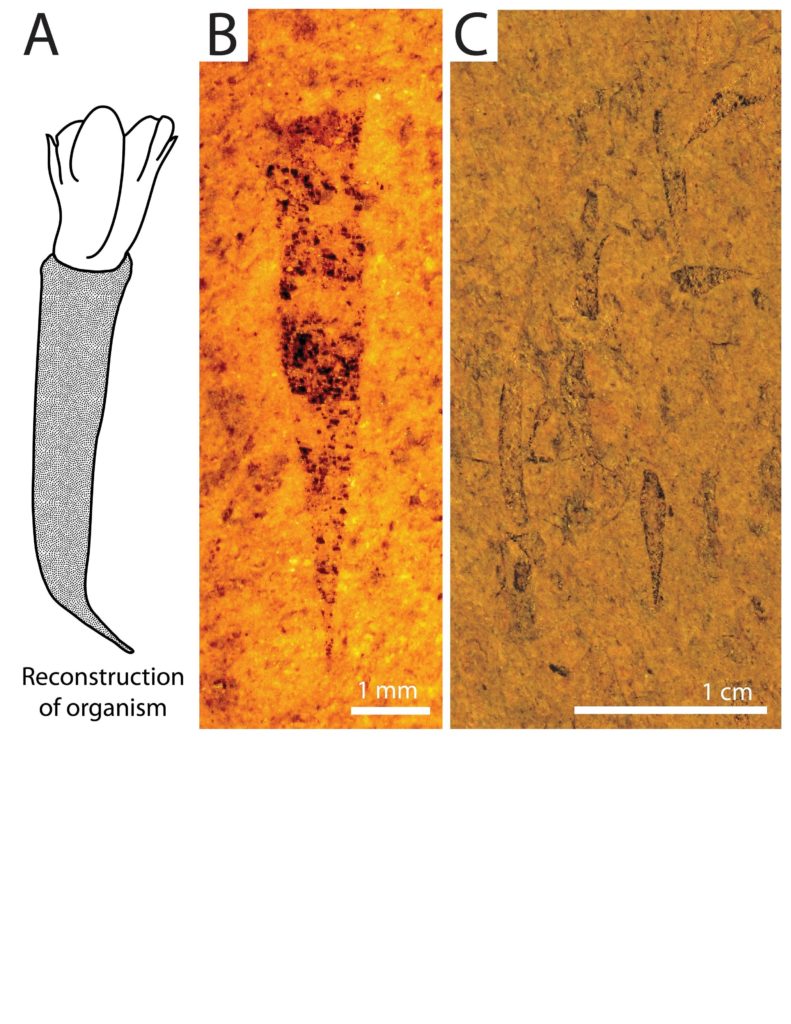@WFS,World Fossil Society,Riffin T Sajeev,Russel T Sajeev

Hummelstown Fossils. A) Typical specimen reconstruction showing body mass (white) poking out of the ‘spindle’-shaped cone (patterned). Note the presence of ‘spikes’ on the sides of the exposed body. B) Typical fossil specimen with body mass (with at least one spike) and ‘spindle’-shaped cone. C) Surface of rock slab showing numerous Hummelstown fossils. Credit: University of Leicester
Researchers from the University of Leicester, working with an international team of geologists, have discovered an enigmatic fossil of a 450 million year-old creature resembling a tiny ice-cream cone. Fossils of the creature, in which the ‘body’ resembles a scoop of ice cream atop the cone, was located in the Appalachian Mountains, near Hummelstown in Pennsylvania from the Ordovician period.
Intriguingly, the rocks in which the fossil was found have been ‘cooked’ during mountain building, which usually hinders fossil preservation.
Discovered by consulting geologist Bob Ganis, who obtained his PhD from the University of Leicester, and Mike Meyer of the Carnegie Institute of Science, it has now been described in a paper published in the journal Palaios by them and co-authors Professor Jan Zalasiewicz of the University of Leicester, Jacalyn Wittmer of the State University of New York, Geneseo and Kenneth de Baets of Geozentrum Nordbayern in Erlangen Germany.
The paper discusses the possibilities of this newly found soft-bodied creature, which lived among the plankton before being carried to the sea floor and buried within mud slurries.
Professor Jan Zalasiewicz from the University of Leicester’s School of Geography, Geology and the Environment, said: “The ancient world of the Ordovician, some 450 million years ago, was one of a huge expansion of life in the seas of our planet.
“Fossils are abound in Ordovician strata, but almost all of them are of creatures with hard shells or support structures, and so our understanding of booming Ordovician life is almost completely based on skeleton-bearing animals. There are few of those rare, precious localities where softer-bodied animals might be found, to give a wider insight into the life of those times.
“Was this creature an important but usually unpreserved part of ocean life, or just a bit player among the Ordovician animal communities? It is a new puzzle for palaeontologists.”
Mike Meyer, of the Carnegie Institute of Science, said: “That this fossil still has the soft bits preserved, even though the rocks that hold it have been squeezed and twisted, is remarkable. This enigmatic organism has major implications for how we look for well-preserved fossils.”
Bob Ganis added: “It’s a small fossil with a big story.”
More information: MIKE B. MEYER et al, A LATE ORDOVICIAN PLANKTIC ASSEMBLAGE WITH EXCEPTIONALLY PRESERVED SOFT-BODIED PROBLEMATICA FROM THE MARTINSBURG FORMATION, PENNSYLVANIA, PALAIOS (2018). DOI: 10.2110/palo.2017.036



 January 24th, 2018
January 24th, 2018  Riffin
Riffin  Posted in
Posted in  Tags:
Tags: 